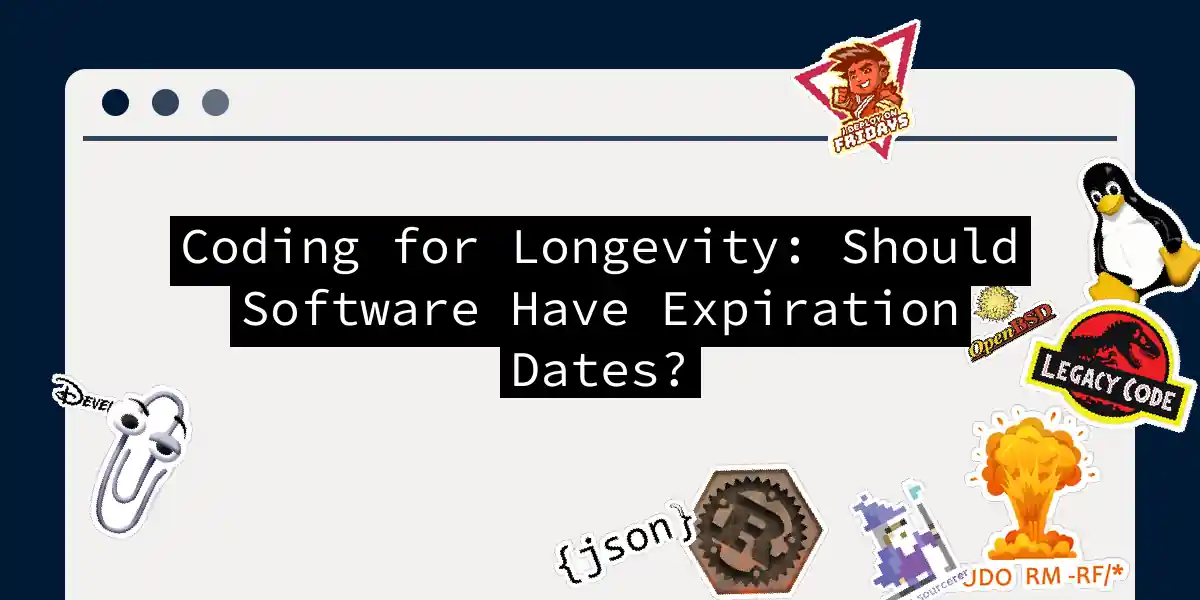Picture this: you’re digging through an old codebase and stumble upon a dusty module labeled “DO NOT TOUCH – WORKING FINE SINCE 2012”. We’ve all been there. Software doesn’t mold like bread, but it certainly expires in its own way. Today, we’re cracking open the debate: should we bake expiration dates into our code? Grab your favorite caffeinated beverage – this’ll be a spicy one.
Why Expiration Dates Aren’t Just for Yogurt
Modern software is a ticking dependency timebomb. Consider:
- 87% of apps contain outdated libraries with known vulnerabilities
- The average JavaScript project has 79 transient dependencies
- Legacy systems cost businesses 23% more in maintenance annually
Security isn’t the only casualty. Ever tried firing up a Ruby on Rails 3 app in 2025? It’s like trying to start a Model T with a USB cable. Dependency rot turns once-shiny code into digital quicksand.
The Case for Code Expiration Dates
Let’s get controversial: expiration dates force accountability. Here’s how to implement them without chaos:
Step 1: The Version Expiry Check
Add this Python decorator to critical modules:
from datetime import datetime
def expire_by(date_str):
def decorator(func):
def wrapper(*args, **kwargs):
if datetime.now() > datetime.strptime(date_str, "%Y-%m-%d"):
raise DeprecationError(
f"{func.__name__} expired on {date_str}. Update immediately!"
)
return func(*args, **kwargs)
return wrapper
return decorator
# Usage:
@expire_by("2025-12-31")
def process_payments():
# Your payment logic here
Step 2: Dependency Expiration Tracking
Embed this in your CI/CD pipeline:
# .github/workflows/expiry_check.yml
name: Dependency Expiry Audit
on: [push, schedule]
jobs:
audit:
runs-on: ubuntu-latest
steps:
- uses: actions/checkout@v4
- name: Check for expired dependencies
run: |
npm install -g depcheck
depcheck --fail-on=expired
if: ${{ failure() }}
run: echo "##vso[task.logissue type=error]Expired dependencies found!"
Pro move: Pair this with automated dependency PR bots that send upgrade reminders like digital nagging assistants.
The Counterargument: When Immortality Matters
Not all code belongs on an expiration conveyor belt. Consider:
- Medical devices running 20-year-old firmware
- Space probes where updates require interstellar FedEx
- Banking mainframes where “if it ain’t broke…” is gospel As one grumpy senior dev once told me: “Kid, the IRS still runs COBOL. Your JavaScript framework isn’t that important.” Touché.
The Middle Path: Selective Shelf Lives
Instead of blanket expirations, implement context-aware longevity:
Practical Implementation Framework
- Categorize by risk:
- 🚨 Red zone (security/data-sensitive): Hard expiration dates
- 📊 Yellow zone (internal tools): Warning banners after 18 months
- 🌱 Green zone (static utils): No expiration
- The “Legacy Will”:Store this in
## LEGACY INSTRUCTIONS [System Name]: Payment Processor v2.3 Expiry Date: 2026-06-30 Successor System: /payments/v3 Contact: [email protected] Failure Modes: - Will reject transactions after 2026-07-01 - Logs "EXPIRED SYSTEM" hourly during grace month/system_wills/README.mdin every repo.
Why This Isn’t Just Nerdy Pedantry
Consider the $4.6B Marriott breach – caused by unpatched legacy systems. Or the Log4j fallout that turned sysadmins into panic baristas. Expiration dates aren’t about killing old code – they’re about respecting the lifecycle. As I wrestle with a 2017 webpack config that now resembles hieroglyphics, I’m reminded: software isn’t wine. It doesn’t improve with age. What if we treated code like milk cartons? “Best before” stamps might just save us from ourselves. Your move, developers. Do we keep building digital pyramids hoping they’ll last millennia? Or do we embrace planned obsolescence as an act of digital hygiene? The comments section awaits your hot takes…
